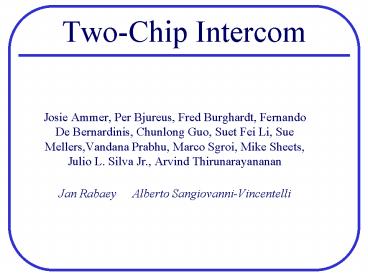TwoChip Intercom - PowerPoint PPT Presentation
1 / 12
Title:
TwoChip Intercom
Description:
Medium Access Control: TDMA (20 slots) Type of data: voice ... TDMA slot map gives slot owner right of refusal. Unowned/unused slots fall to round-robin arbitration ... – PowerPoint PPT presentation
Number of Views:67
Avg rating:3.0/5.0
Title: TwoChip Intercom
1
Two-Chip Intercom
- Josie Ammer, Per Bjureus, Fred Burghardt,
Fernando De Bernardinis, Chunlong Guo, Suet Fei
Li, Sue Mellers,Vandana Prabhu, Marco Sgroi, Mike
Sheets, Julio L. Silva Jr., Arvind
Thirunarayananan - Jan Rabaey Alberto Sangiovanni-Vincentelli
2
Intercom
- Wireless network of approx. 40 Remote Terminals
(RT) - Network coordinated by a Base Station (BS)
- Medium Access Control TDMA (20 slots)
- Type of data voice
- Type of services Connection, Multi-way
Conference, Users Query
RT/BS
3
Intercom Board
4
Two-Chip Intercom
Program-mable logic
Software running on processor
Custom analog circuitry
Mixed analog/ digital
Fixed logic
Protocol
ADC
Digital Baseband processing
Analog RF
DAC
Chip 2
Chip 1
5
Protocol Layers and Interfaces
Voice samples
Service Requests
User Interface Layer
UI
Mulaw
Mulaw
Transport Layer
Transport
Mac Layer
MAC
Filter
Error Control Layer
Transmit
Receive
Synchronization Layer
Synchronization
Tx_data
Rx_data
Tx/Rx
6
Target Implementation Platform
Memory Sub-system
Tensilica Embedded Proc.
Sonics Backplane
Programmable Protocol Stack
ConfigurableLogic (Physical Layer)
Baseband Processing
7
Sonics Bus Model
Arbiter
IClk
SBClk
SBClk
TClk
Initiator Core
Initiator Agent
Interconnect
Target Agent
Target Core
OCP
OCP
Processor
Clock synch., SB handshaking
Clock synch., SB handshaking
Memory, I/O ports
Pipelined commands Posted writes Selectable read
latency
Sonics SiliconBackplane
Sender
Receiver
- Flexible bandwidth arbitration model
- TDMA slot map gives slot owner right of refusal
- Unowned/unused slots fall to round-robin
arbitration - SBClk typically different from IClk and TClk so
synchronization required - Latency after slice granted is user-specified
between 2-7 SBClk cycles
8
Describing The Protocol Stack
Development time 4 person-month
- Cadence VCC Polis
- Model of Computation CFSM
9
Mapping The Protocol Stack
Architecture Exploration 4 archs. per
day Convergence 1 week!
10
Physical to Protocol Interface Design
Goal Decouple physical layer and protocol layer
development
Step 1 Develop radio operating mode to match
application requirements Step 2 Define interface
signals and behavior with no associated timing
constraints (design based on interface to a
commercially available radio) Step 3 Create
wrapper for existing physical layer that
implements the interfaceCreate wrapper for
existing protocol layer that implements the
interface Step 4 Determine timing information
and constraints using physical layer simulations
and analysis
Physical Layer
Protocol and above
MACLayer
TransLayer
App.Layer
Base-band
RF
SynchLayer
UI
Chip 2
Chip 1
Proxim-like wrapper
7 wire PPI (physical-to-protocol interface)
11
Physical Layer Development
Stage 1 floating point blocksStage 2 fixed
point blocks
Stage 1 Model components in MATLAB tools at
appropriate granularities Behavioral level
Simulink -- RF, ADC, DACStructural level in
Simulink -- Digital BB (initially in floating
point) Structural level in Stateflow --
Control Verify Basic functionality. Determine
timing information and constraints Stage 2
Convert underlying Simulink structural blocks
(manually) to fixed point/bit-true Verify Bit
width effect on performance Stage 3 Synthesize
to HW (automatic synthesis path Simulink to
HW) Verify Implementation meets timing
requirements
12
Physical Layer Timing Analysis
- Analysis of simulations yields high-level numbers
(such as radio turnaround time and transmission
latency)
Tool Microsoft Excel

